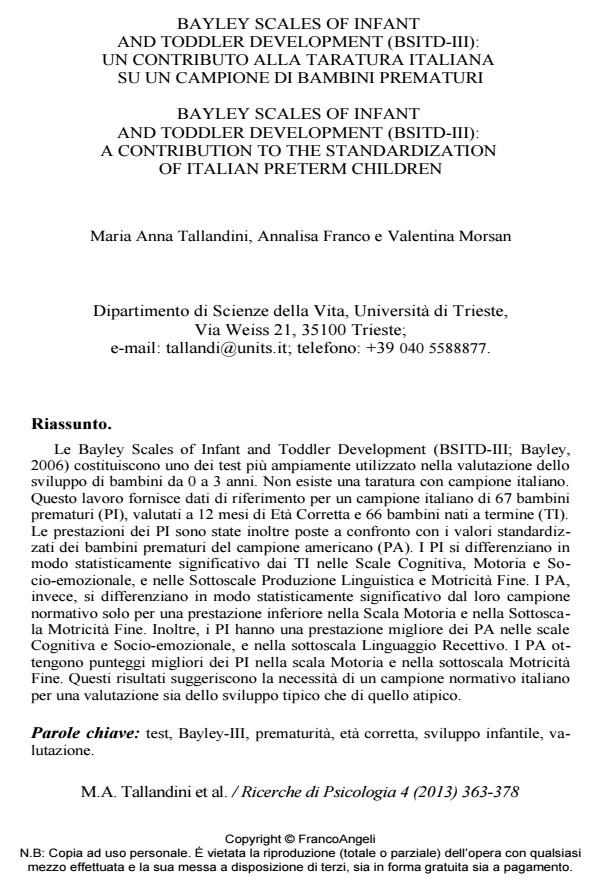Bayley scales of infant and toddler development (bsitd-iii): un contributo alla taratura italiana su un campione di bambini prematuri
Titolo Rivista RICERCHE DI PSICOLOGIA
Autori/Curatori Maria Anna Tallandini, Annalisa Franco, Valentina Morsan
Anno di pubblicazione 2014 Fascicolo 2013/4
Lingua Italiano Numero pagine 16 P. 363-378 Dimensione file 661 KB
DOI 10.3280/RIP2013-004002
Il DOI è il codice a barre della proprietà intellettuale: per saperne di più
clicca qui
Qui sotto puoi vedere in anteprima la prima pagina di questo articolo.
Se questo articolo ti interessa, lo puoi acquistare (e scaricare in formato pdf) seguendo le facili indicazioni per acquistare il download credit. Acquista Download Credits per scaricare questo Articolo in formato PDF

FrancoAngeli è membro della Publishers International Linking Association, Inc (PILA)associazione indipendente e non profit per facilitare (attraverso i servizi tecnologici implementati da CrossRef.org) l’accesso degli studiosi ai contenuti digitali nelle pubblicazioni professionali e scientifiche
Le Bayley Scales of Infant and Toddler Development (BSITD-III; Bayley, 2006) costituiscono uno dei test piu ampiamente utilizzato nella valutazione dello sviluppo di bambini da 0 a 3 anni. Non esiste una taratura con campione italiano. Questo lavoro fornisce dati di riferimento per un campione italiano di 67 bambini prematuri (PI), valutati a 12 mesi di Eta Corretta e 66 bambini nati a termine (TI). Le prestazioni dei PI sono state inoltre poste a confronto con i valori standardizzati dei bambini prematuri del campione americano (PA). I PI si differenziano in modo statisticamente significativo dai TI nelle Scale Cognitiva, Motoria e Socio- emozionale, e nelle Sottoscale Produzione Linguistica e Motricita Fine. I PA, invece, si differenziano in modo statisticamente significativo dal loro campione normativo solo per una prestazione inferiore nella Scala Motoria e nella Sottoscala Motricita Fine. Inoltre, i PI hanno una prestazione migliore dei PA nelle scale Cognitiva e Socio-emozionale, e nella sottoscala Linguaggio Recettivo. I PA ottengono punteggi migliori dei PI nella scala Motoria e nella sottoscala Motricita Fine. Questi risultati suggeriscono la necessita di un campione normativo italiano per una valutazione sia dello sviluppo tipico che di quello atipico.
Parole chiave:Test, Bayley-III, prematurita, eta corretta, sviluppo infantile, valutazione.
Maria Anna Tallandini, Annalisa Franco, Valentina Morsan, Bayley scales of infant and toddler development (bsitd-iii): un contributo alla taratura italiana su un campione di bambini prematuri in "RICERCHE DI PSICOLOGIA " 4/2013, pp 363-378, DOI: 10.3280/RIP2013-004002